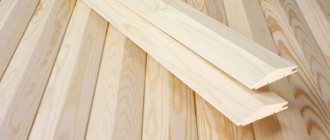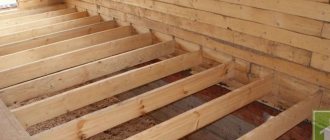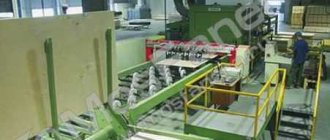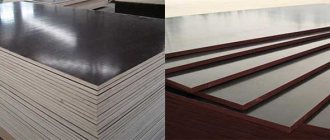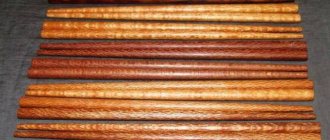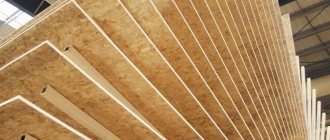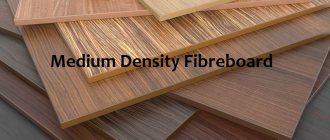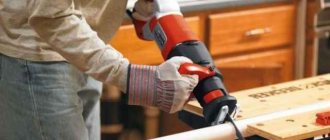How to quickly and efficiently, but at the same time with minimal waiting time, level the floors in an apartment or house? If the speed of work is very important, and creating a conventional cement screed is impossible, then a DSP board is perfect for this purpose. The use of this building material for flooring allows you to make surfaces smooth very quickly. In this case, the coating will be durable and of high quality.
DSP board - application for flooring
Cement particle boards: application in construction
DSP is a cement-bonded particle board, and the name fully reflects the composition of this material. DSPs are made from a mixture whose components are wood shavings and cement compounds.
What are DSP and OSB? What is the difference?
The building materials include:
- wood shavings with fractions of various sizes – 24%;
- water – 8.5%;
- special additives – 2.5%;
- Portland cement – 65%.
DSP boards for external use
The production process is quite simple - DSP is made as follows.
- Special aqueous solutions are loaded into special mixers, which include various salts, liquid glass and aluminum.
- Next, wood shavings with fractions of different sizes are gradually added to these solutions - mineralization of the raw material occurs.
- Cement is mixed into the resulting composition and a little more water is added.
- The mass is thoroughly mixed until smooth and then goes under a powerful press.
GOST 26816-86. Cement particle boards . Technical conditions. Downloadable file (click the link to open the PDF in a new window).
GOST 26816-86
The result of this production chain is a finished cement bonded particle board, which is quite thin and has a smooth surface. A large amount of cement in the composition allows you to create a fairly durable material. By the way, the chips inside the slab are larger in size than outside, due to which the smoothness of the surface of the finished material is achieved. DSP does not need to be further leveled after installation, making the material excellent for creating a rough floor covering for laminate, tile and other types of finishing. Also, no voids are formed inside the DSP during production.
Production of cement particle boards
On a note! Wood shavings are also used as a raw material in the production of chipboard, fiberboard and OSB boards. The technologies for producing these materials are somewhat similar to the technology for producing CBPB boards.
Comparative table of performance characteristics of wood-based materials
Expert opinion
Afanasyev E.V.
Chief editor of the pol-exp.com project Engineer.
DSP boards are widely used in construction. They can be used to decorate the facade walls of houses, and they can be used to create various partitions indoors. The material is suitable for use for restoration purposes and for interior finishing work. Moreover, it is suitable for both apartments and private houses.
DSPs are used in construction for many purposes
The DSP board is characterized by high environmental friendliness, as it is created from natural materials and practically does not contain additional chemical ingredients. That is why the stove is recommended for use both in residential premises and in production.
Cement particle board (CSP)
Using a cement bonded particle board is an opportunity to avoid the labor-intensive pouring of cement screed to create a base. The building material allows you to reduce labor costs and spend less money from the budget planned for leveling floors for laying the finishing coating.
Installation of a DSP board under ceramic tiles
Features of use
Application options for CBPB boards depend on the characteristics of the material.
The first important parameter is thickness . For cladding partitions, DSP with a thickness of 8 to 24 mm is suitable. Columns and crossbars are lined with material from 8 to 16 mm, and external walls from 10 to 24 mm.
The base for screeding the floors and attic of the house is made of moisture-resistant DSP 12–24 mm. Slabs of 20, 24 or 36 mm are laid under the subfloor. For window sills and steps, sheets of 24 or 26 mm are suitable.
Installation rules
Installation methods depend on the intended operating conditions, but the following rules are always followed:
- cutting carried out with the same tools as wood; it is undesirable to use expensive hacksaws, since cement quickly grinds off the teeth;
- fastening carried out with nails or self-tapping screws, the second option is preferable, as it ensures a tight fit;
- under the head of the self-tapping screw place the puck — this will prevent the destruction and pushing of the slab under large forces applied when tightening the hardware;
- drilling carried out with hand or electric drills, ceramic drills with carbide tips are used.
Lathing for fastening slabs up to 50 mm thick is made in increments of 60 cm; for thicker products, the increment can be increased to 100 cm.
Finishing "wet facade"
An external wall made of cement-bonded fiberboard can be made using the “wet facade” technology:
- Using glue and dowels with wide heads the slabs are mounted in the wall ; be sure to take into account the weight of the DSP, increasing the number of attachment points. Work begins from the bottom of the wall, the material is fastened in a checkerboard pattern.
- The surface is protected with a reinforcing mesh , which is glued with cement-based mounting adhesive.
- After the first layer has dried, plaster is applied, and then putty is applied .
- The final finishing consists of painting or installing siding .
When installing floors, CBPB is laid on a cement-sand screed. Fastening is carried out with dowels. Gaps of 3–4 mm must be left between the slabs, which are filled with cement mortar.
In the construction of warm roofs, DSP is used as water and wind insulation. The material is mounted between the rafters, screwed to the inside of the sheathing.
Characteristics of CBPB boards
DSP is a completely new category of material, characterized by significant strength, long service life, and a certain level of moisture resistance. It also has good soundproofing and heat-saving properties. All these features have allowed CBPB boards to take a strong place in the construction industry - they are used for various purposes.
Of course, this material is far from ideal, but still, thanks to its properties and characteristics, it can be used both outside and inside the building. The DSP board does not lose its qualities in a wide variety of climatic conditions.
DSP
On a note! Compared to chipboard, which is common for many, a board based on cement and shavings is 3 times stronger and has high resistance to various physical influences and loads.
Table. Key parameters of the DSP.
| Length, m | Thickness, mm | Width, m | Area, sq. m. | Number of sheets in 1 cubic meter, pcs. |
| 2,7 | 8 | 1,25 | 3,375 | 37 |
| 2,7 | 10 | 1,25 | 3,375 | 29 |
| 2,7 | 12 | 1,25 | 3,375 | 24 |
| 2,7 | 16 | 1,25 | 3,375 | 18 |
| 2,7 | 20 | 1,25 | 3,375 | 14 |
| 2,7 | 24 | 1,25 | 3,375 | 12 |
| 2,7 | 36 | 1,25 | 3,375 | 8 |
| 3,2 | 8 | 1,25 | 4 | 31 |
| 3,2 | 10 | 1,25 | 4 | 25 |
| 3,2 | 12 | 1,25 | 4 | 20 |
| 3,2 | 16 | 1,25 | 4 | 15 |
| 3,2 | 20 | 1,25 | 4 | 12 |
| 3,2 | 24 | 1,25 | 4 | 10 |
| 3,2 | 36 | 1,25 | 4 | 7 |
The density of one cubic meta CBPB board is quite high - about 1300-1400 kg/m3. The moisture content of the material is 6-12%. By the way, the material is not 100% protected from the effects of water, but swelling upon contact with liquid over a full day should not exceed 2%.
Characteristics of cement bonded particle boards
The slab is rough to the touch, but smooth - often these indicators depend on the grinding method used. Sometimes the DSP does not need the latter - if the roughness level is no more than 80 microns. The plate is selected in accordance with the operating conditions, as well as the requirements for the final results. For example, smooth slabs are usually used indoors, but rougher slabs can be used outside.
On a note! Finishing of DSP boards is simple - any type of floor finishing can be laid on them, and paint, varnish, plaster, etc. can be easily applied to the surface.
Cement particle board - transportation
Kinds
There are three types of DSP. Studies of the material have accurately shown that each of them does not lose its valuable properties even during multiple cycles of significant temperature increases and subsequent defrosting.
Resistance to fire and particularly humid environments, as well as negative biological factors, was also confirmed. But each type of slab has its own characteristics, which include the production method, the difference in source materials, the characteristics of the finished product and the scope of application. Among the types you can indicate.
1. Fiberboard. Its basis is the so-called wood wool, which is long-fiber shavings. The composition also includes inorganic binders.
Wood strips produced on special machines are impregnated with solutions of calcium chloride and liquid glass. The raw materials are pressed into molds and subsequently dried. The thickness of such slabs can reach 150 mm, but there are a number of much thinner parameters.
These building elements, with their considerable strength, are excellent for thermal insulation. A similar material is also used as an acoustic material.
It is easy to process and soft, for this reason it is in demand for multifaceted repairs, as well as reconstruction work of various structures. During construction operations with slabs, due to their low weight, lifting equipment is not required, and therefore their use is very economical.
2. Wood concrete. It is classified as lightweight concrete and contains small shavings, sawdust, reed chaff or rice straw. The highest quality slabs of this variety are made from wood chips.
If the basis of the composition is wood shavings, then the material is usually called wood concrete, if sawdust - sawdust concrete. The two types mentioned have slightly reduced performance characteristics compared to the first one mentioned above.
They are heavier, denser and subject to unpleasant deformations, but they are also somewhat cheaper. The scope of application of wood concrete is quite wide. But mainly it is in demand as a material for low-rise private construction, especially popular in the manufacture of wall partitions, also for finishing and thermal insulation.
3. Xylolite is most often known for its use as a DSP coating for floors . Plates , similar to those previously described, are made from wood waste, differing from other types in production technology. On sale, the presented assortment pleases with a variety of colors.
The material is distinguished by excellent thermal insulation qualities and increased strength. It does not burn in an open fire, but only gradually chars; even when boiling, it does not get wet in water and is only slightly thermally conductive; It has enviable elasticity and is hard like stone, but at the same time it is easily processed like wood: drilled, planed and sawed. In addition to the above, it is ideal for use as cladding for stone, covering stairs, window sills, and roofs.
An important characteristic is the weight of the CBPB board . Such indicators are simply necessary to know during construction and other work. The specified data is very useful during cargo transportation and during installation work. The mass of one module directly depends on the thickness and, knowing this indicator, it is easy to calculate. After all, for every 10 mm there is approximately 54 kg of tile weight.
Advantages and disadvantages
What are the main advantages and disadvantages of slabs over other similar materials? Let's look at the answer to this question in more detail.
Pros and cons of CBPB boards
Advantages of DSP:
- environmental friendliness of the material, as it is made from natural ingredients. DSP does not contain asbestos and formaldehyde-containing substances;
- fungus and mold do not settle on the slabs
- the material is not hygroscopic - this is its main advantage over chipboard;
- DSP does not suffer from temperature changes and does not lose its performance qualities;
- 100% non-flammability of DSP boards allows them to be used in any room. The material can withstand fire for 50 minutes;
- reasonable price , allowing you to purchase material even if you have a small budget;
- significant strength due to multi-layer material. Excellent performance is observed under pressure both from the end of the plate and from any of the other sides;
- the slab does not require additional leveling of surfaces ;
- the material is not afraid of chemical influences;
- cement particle board perfectly resists rotting processes;
- relative impermeability to water - during the day, DSP is able to absorb a maximum of 16% of liquid;
- high noise insulation and heat insulation qualities;
- ease of installation.
DSP boards have many advantages
On a note! It is recommended to use DSP boards when installing a water heated floor system. In this case, it will be possible to create an additional air gap between the heating and the finishing coating, which will significantly improve the result of the work done.
The disadvantages of plates are as follows:
- large mass of material, which makes working with it difficult;
- During processing, the DSP generates a lot of dust . If you have to cut slabs, you should wear a respirator and safety glasses to avoid harm to your eyesight and respiratory organs.
The easiest way to finish DSP boards is to paint them with acrylic or silicone-based compounds, leaving deformation gaps between adjacent sheets
However, the material has many more advantages than disadvantages, which explains its popularity in construction, including for leveling floors. Typically, CBPB slabs are laid on logs - this is the best option for using the material in this area. More often, DSP is installed under laminate, carpet, linoleum, and ceramic tiles.
In general, it can be noted that in most respects, CBPB boards are superior to plasterboard, chipboard and fiberboard, which makes them one of the best building materials. Also, DSP will save a lot of money if a choice is made in their favor.
Cement particle board for flooring
Processing and installation methods
When installing DSP, like any other finishing material, it often becomes necessary to give it a certain shape.
Unlike plywood, OSB and other similar materials, DSP cannot be cut with an electric jigsaw .
The cement stone quickly wears down the teeth of the blade until they completely lose their cutting ability. Therefore, to cut this material it is advisable to use :
- angle grinder (angle grinder, grinder) with a stone disc;
- circular saw with diamond blade.
DSP can also be milled using a hand router or copy router, as well as a carbide-tipped attachment. For drilling, you can use a drill with both conventional metal drills and those with a tip made of tungsten carbide.
To attach a cement-bonded particle board to any base, nails and hardened metal screws are used. A hole is drilled for the entire length for the nails; for self-tapping screws, it is necessary to drill a recess for the head, slightly larger in size.
For any machining of CBPB it is necessary to use:
- respirator;
- protective glasses;
- vacuum cleaner.
Cement stone, when exposed to it, releases a lot of dust, which poses a threat to the eyes and respiratory system, so protective equipment and a vacuum cleaner will keep you healthy.
DSP in insulation works
Most often, DSP is used in the field of insulation of buildings and structures. Usually the material is sheathed on the outside of the building. Fixation is done using self-tapping screws or nails.
But, since DSP is an environmentally friendly material, wall and floor cladding can also be done from inside the room. The sheathing process is similar to what is done outside: the material is attached to a wooden or metal sheathing using nails or self-tapping screws. Sometimes adhesive mastics can also be used. After installation of the slabs, finishing is carried out.
Sheathing frame structures using cement bonded particle boards is a reasonable solution
What is the price?
The price of cement particle boards depends on:
- compliance with GOST;
- type of plate (TsSP-1 or TsSP-2);
- quality of processing (polished or unpolished);
- sheet size and weight.
Material that complies with GOST 26816-86 is always more expensive than that made without regard to this document. To some extent, the indication of GOST 26816-86 in the name of a building material is synonymous with a quality mark , regardless of the place of manufacture of the slab. We have prepared a table that includes the most popular manufacturers of chipboards and their official dealers, as well as the price per sheet of their products:
| Manufacturer or seller name | Slab dimensions (length, width, thickness in mm) | Cost in rubles | Cities where production and main representative offices are located |
| Individual entrepreneur Bogdan Vladimir Ivanovich, official dealer of Tomak CJSC in the Krasnodar Territory | 3200x1250x10 | 880 | Production Tambov. Representative offices Moscow, Krasnodar |
| 3200x1250x16 | 1205 | ||
| 3200x1250x20 | 1505 | ||
| 3200x1250x24 | 1665 | ||
| LLC "TsSP-Svir" | 3200x1200x8 | 715 | Production Lodeynoye Pole (Leningrad region). Representative offices Moscow, St. Petersburg |
| 3200x1200x10 | 742 | ||
| 3200x1200x12 | 824 | ||
| 3200x1200x16 | 985 | ||
| 3200x1200x20 | 1255 | ||
| 3200x1250x10 | 817 | Manufactured in Moscow. Representative office Moscow | |
| 3200x1250x16 | 1158 | ||
| 3200x1250x20 | 1415 | ||
| 3200x1250x24 | 1654 | ||
| 3200x1250x10 | 1080 | Production Krasnodar. Representative offices Moscow, Sevastopol | |
| 3200x1250x16 | 1430 | ||
| 3200x1250x20 | 1730 | ||
| 3200x1250x24 | 1900 |
As can be seen from the table, the cost of wood-cement boards or panels depends on their size, the thickness of the sheet and, accordingly, its weight, which we talked about earlier: for each thickness indicator - be it 8mm, 10mm, 12mm, 16mm, 18mm, 20mm, 24mm or any other will have its own price per sheet or per m2 of material.
In addition, an unsanded slab with a thickness of 10 mm or 12 mm will cost less than a sanded slab of similar sizes.
Application for floor
DSP is often used to create a subfloor. Most often, the material is laid with the expectation that in the future ceramic tiles will be glued to it - this is the most demanding coating in terms of the evenness of the base. DSPs are also suitable for pouring three-dimensional floors and for installing soft floor coverings.
Scheme for the implementation of water heated floors using DSP boards
DSP slabs can be mounted on logs, and also laid on a flat concrete or wooden base. The material lasts for many years and is able to withstand significant loads if installed correctly.
DSP slabs for flooring - photo
Price
The price of DSP boards varies. It is determined by the plant and the direct supplier. But, if we consider the middle segment of the market, then for an 8-meter particle board, it is quite possible to pay from 700 rubles. per sheet. We already talked about sizes earlier. So, the average sheet area is almost 3.83 square meters.
If we compare this price with OSB sheets, then for a similar square footage we can pay more than 1000 rubles. Therefore, particle board is more profitable than other finishing materials.
Otherwise, decide on the thickness and remember that the larger it is, the more expensive the cost of one sheet will be. For example, a similar sheet, but with a thickness of 12 mm, can be found on sale at a cost of 1,100 rubles.
Choosing cement sheets for the floor
The choice of DSP boards is carried out in accordance with the conditions in which the material will be used, as well as the technology by which its installation will be carried out. For laying on logs, slabs with a thickness of 20-26 mm are used - they will perfectly cope with their function as a rough base. If installation is carried out directly on the ground, then 24-26 mm slabs are used. In general, almost any DSP board can be used to level floors.
Average market prices for material
On a note! DSP boards can be laid even in cold weather. It doesn’t matter if the air temperature outside the window drops below zero.
Requirements for CBPB slabs used for floor installation:
- humidity – from 6 to 12%;
- density – more than 1300 kg/m3;
- tensile strength – 0.4 MPa;
- surface roughness – 80 microns;
- moisture absorption level – 16%.
For the floor, DSP boards must be used that meet a number of requirements
Comparison with other materials
For comparison with other materials, we suggest using characteristics such as:
- fire safety;
- ease of installation;
- resistance to mold and disease;
- builder reviews;
- reviews from residents and home owners.
Fire safety and flammability class
In this parameter, DSPs are superior not only to polymer insulation and PVC, but even to wood concrete. DSP is assigned a flammability class - G1, that is, they are difficult to burn. Due to the large proportion of cement, each of the shavings is surrounded by a cement stone, therefore, to begin the pyrolysis process in wood located close to the surface, exposure to a temperature of 500 degrees or more for half an hour is necessary .
Once the thermal effect is removed, the pyrolysis process is quickly completed, because close contact of many chips is necessary for the self-sustaining reaction to begin.
If the temperature exceeds 700 degrees, and this effect lasts for over an hour, then pyrolysis of the chips begins throughout the entire depth of the slab.
At this temperature, any building materials sharply lose strength, and concrete completely collapses. Therefore, after a fire of such magnitude, the house cannot be repaired, unless the fire was local in nature and burned only a small area of the house.
Even the beginning of the pyrolysis process does not lead to the release of particularly toxic substances , because the main components of pyrolysis gas (smoke) are:
- nitrogen;
- carbon dioxide;
- carbon monoxide.
Only carbon monoxide poses a serious danger, but, firstly, very little of it is released during the pyrolysis process, and secondly, during a fire, combustion occurs in conditions of lack of oxygen, so carbon monoxide is released everywhere in huge quantities.
Therefore, DSP is one of the safest materials in terms of fire and is comparable to gypsum plasterboard and fiberboards. It is much safer than finishing from:
- plywood;
- OSB;
- chipboard;
- Fiberboard;
- boards;
- wood concrete;
- insulating fiberboards;
- foams and plastics.
Ease of installation
Due to the high cement content, CBPB is much heavier than most other finishing materials.
The weight of thin sheets is 25–45 kg, so a minimum of 2 people are required to work with them.
To work with thick sheets, 5-6 people are needed, because the weight of a sheet with a thickness of 26 mm exceeds 200 kg.
Cutting the material is also fraught with difficulties, because it is necessary to use a high-speed circular saw and a diamond-coated or carbide-tipped blade.
Therefore, in terms of ease of installation, DSP is inferior to most finishing materials. After all, its weight, with equal dimensions and thickness, exceeds the weight of any other finishing material, including LSU and wood concrete.
Resistant to mold and disease
Due to the fact that the wood in CBPB does not have direct contact with air, it is less susceptible to mold and disease.
In addition, for products manufactured in accordance with GOST requirements, the chips are pre-soaked in a lime solution or other reagents that increase the biological stability of wood.
The content of lime, liquid glass and other reagents that suppress biological activity in the solution makes DSP less sensitive to mold and disease than most other finishing materials, with the exception of plastics.
Reviews from builders and residents about wood-cement blocks
To collect the most reliable reviews about the characteristics, application and prices of DSPs, we turned to forums, whose users include:
- professional builders;
- experienced engineers;
- owners of apartments and houses;
- people with experience in carrying out independent repairs.
Here is a list of forums with DSP discussion threads:
- Forumhouse;
- Forumgrad;
- NGS House;
- Vegalab;
- We are building a house;
- Mastergrad;
- Ideas for your home;
- Forum of self-builders Okolotok.
Preparing for the installation of a DSP coating
Before starting work on arranging a rough surface made of CBPB, the base of the floor must be properly prepared. For example, when laying material on a wooden base, old or rotten boards must be dismantled and replaced with new ones. It is important to seal all the cracks with putty, and the wooden base is primed for better adhesion to the glue on which the slab covering will be mounted.
If installation will be carried out on a concrete base, then it should also be carefully inspected for damage and repaired if necessary. Also, if there are strong horizontal deviations, leveling is done with cement mixtures. When laying CBPB on the ground, it is necessary to first level the surface - this can be done by pouring a 20 cm thick sand-gravel mixture onto the ground and compacting it.
The process of building a gazebo with a DSP floor
The best option is to lay CBPB slabs on logs. In this case, if it is planned to install the foundation directly above the ground, supports for the logs are installed on the ground, and hydro- and thermal insulation is also laid. The distance between the supports can vary from 0.5 to 1 m - this indicator depends on the thickness of the timber used for the logs.
Materials and tools that need to be prepared for working with DSP:
- timber for logs (section 150x100 or 50x100 mm);
- DSP boards in the required quantity;
- antiseptic solution for timber;
- sawing tool (for example, a hacksaw);
- materials for waterproofing and insulation;
- tools for taking measurements (tape measure, pencil);
- fastening material;
- drill.
Fastening floor slabs using self-tapping screws
Characteristics and dimensions
The characteristics of the CBPB board are important at the selection stage:
- The weight of one cubic meter is about one and a half tons. It is important to take this into account when transporting when purchasing large volumes of slabs. Loading of packages is carried out using a manipulator. It can be used to organize delivery and unloading. As for the weight of one slab, it is small and installation can be done manually.
- Humidity up to 12%. This criterion corresponds to the state standard. Low humidity indicates that the stove does not absorb water even during operation. Therefore, it is supplied from the factory with a humidity of 9%, but even if it is used in rooms with high humidity levels, such as bathrooms, the material will not deteriorate at all even after a while. This implies another characteristic, such as water absorption in maximum quantities, which amounts to no more than 16% in one day.
- Sufficient thermal conductivity. Due to the high density of wood chips, the thermal conductivity is fixed at 0.26 watts per square meter. This is enough to use similar material in frame houses. Vapor permeability is 0.03.
- The material can withstand bending pressure up to 9 megapascals. As for the compression pressure, this value is 0.4 megapascal. Flammability is equivalent to class G1.
The technological feature of production allows us to produce slabs of different thicknesses on the market. Basically, they are fixed values from 0.5 centimeters to 4 cm, inclusive. The width may also vary. It is fixed at 120 and 125 cm, respectively.
Dimensions of CBPB boards
As for the length, this value is fixed at 270 and 320 cm, respectively. The state production standard assumes deviations in the thickness, width and length of the material up to one and a half mm, inclusive.
Arrangement of the floor using DSP
Let's consider the arrangement of a floor made of cement-bonded fiberboard on joists using the example of a balcony.
Step 1. A layer of insulation is laid under the logs. The logs are installed parallel to the walls at a distance of about 30-40 cm from each other.
The joists are installed on top of the insulation
Step 2. Cross bars are installed and the sheathing is created. The wooden blocks are connected to each other using metal corners and self-tapping screws.
Cross bars installed, sheathing ready
Step 3. The space between the joists is filled with insulating material.
Laying insulation
Step 4. DSP boards of the required sizes are laid across the longitudinal joists. The width of the piece of material should be slightly less than the width of the balcony (by 5-10 mm).
Laying CBPB boards
Step 5. The plates are fastened with self-tapping screws to the joists. The gaps between the DSP boards are sealed with an adhesive composition.
Fixing slabs with self-tapping screws
Video - Laying tiles on DSP
How to install correctly and what tools are needed?
Installation of DSP boards can be done by hand. It’s not difficult, the main thing is to follow the basic rules of work. As for the basic rules, we suggest considering installation using the example of arranging the facade of a private house. Here you need to follow the following steps:
1. The foundation needs to be established. These are a kind of bars measuring 50 by 50 mm, which must be fixed to the load-bearing wall. If we have a frame house in front of us, then we can use the existing frame without additional modification.
Since the slab itself weighs a lot, it is not recommended to use timber of a smaller cross-section, unless you can replace it with metal, 50 by 20 mm. The step between two adjacent beams should be no more than 60 cm. Vertical sheathing is performed with the specified step.
2. The insulation is being laid. For this reason, we previously chose a cross-sectional area of 50 by 50 mm. This is convenient for laying insulation with an overlap of 2 and 2 cm, respectively. The overlap is done in order to remove cold bridges at the junction of two plates.
Depending on the original base, the insulation is nailed either with special dowels or fixed to the wooden profile by further installing a wind protection membrane. The membrane is nailed to the tree using a stapler. One cm of space left between the insulation and the DSP board is a ventilation gap. It must be left during installation.
3. Installation of sheets. It is advisable to lay the first sheet perfectly level in order to limit the overall horizon for subsequent installation. The sheets are screwed using a regular wood or metal screw, depending on the base.
Before screwing the sheet, level it, fix it and make markings for further installation. Manufacturers recommend drilling holes for screws. To do this, use a drill of a smaller diameter. If you are not going to drill, then buy self-tapping screws with a drill.
Fasteners must be galvanized or pre-treated with special compounds. It is impossible for two adjacent slabs to fit perfectly against each other. It is important to leave a ventilation gap, which can be up to 0.5 centimeters inclusive.
4. Don’t worry if parts of such a slab break off somewhere. In the future, you can always cover the walls with another material, but even small chips will not harm the overall integrity of the surface. The easiest way to further finish is to paint the surface.
Frame house sheathed with DSP
There are special paints for CBPB, which will give your home a sophisticated look. Paints are produced on the basis of acrylic or silicone, which makes them moisture resistant and allows them to maintain their saturation at critically low and high temperatures.
As for the tool, we need:
- A screwdriver, a drill with a drill whose diameter is smaller than the diameter of the screw.
- Level, wood saw, measuring tape, marking pencil.
Recommendations
The DSP board will facilitate the formation of level bases, reduce the duration of work and reduce costs. Using building materials, it is easy to build floors for a house from foam blocks. When thinking about how to cover a cellar, consider using DSP panels. Using slabs, you can construct a monolithic foundation slab. This base and the Swedish foundation slab are comparable in thermal insulation properties. When engaged in construction, it is worth studying the difference between PC and PB boards. It is quite possible that this will be useful when choosing a material.

